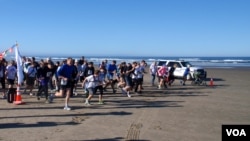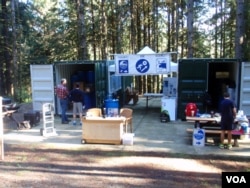It's not often you hear "fun" and "tsunami" in the same sentence, but both words inform the theme and purpose of the inaugural "Race the Wave" 5K fun run and walk in scenic Cannon Beach, Oregon.
The course leads runners down the hard-packed sand before turning up into the hills behind the oceanfront hotels and cottages. At that point, the course follows a designated tsunami evacuation route; paths that have been mapped out because this coast line is vulnerable to the huge sea waves unleashed by undersea earthquakes.
The "ring of fire" is the name for the great arc of volcanoes and grinding tectonic plates around the edges of the Pacific Ocean. This year, big earthquakes have hit Chile, Mexico, Alaska and the Solomon Islands. Geologists have identified the U.S. Northwest as another vulnerable location. While undersea quakes can cause massive damage and loss of life, the tsunamis they generate can be even deadlier.
The idea of a race along an evacuation route was hatched several years ago by one of today's participants who works for the Federal Emergency Management Agency’s regional office. Ryan Ike of Seattle said it’s about inspiring people to practice and create “muscle memory.”
"We’ve seen these [tsunami evacuation] maps and we've put these really beautiful things together and you’re looking at it on a table and you think, ‘OK, I could run from here to here. That’s not that far.’ But then you get to the bottom of the hill, and you realize I have only a few more minutes and I have got to get this much further," he said. "And I have my kids, or I have my bags, or I have all this stuff with me. How would you do that?"
Emergency supplies
FEMA and Oregon’s Office of Emergency Management approached Cannon Beach to host what they hope will be the first of many races. For this race, the finish line is at an emergency supply cache on high ground about one kilometer inland from the ocean.
After a big earthquake, people are supposed to evacuate to this spot by foot -- not by car. Emergency planners assume the Big One -- a magnitude 9.0 quake caused by a full rupture of the dangerous Cascadia fault zone offshore -- will buckle roads, topple trees and bring down power lines from Northern California to British Columbia.
Assuming the source of the tsunami waves is the Cascadia fault zone, most people along the Northwest coast would need to get to higher ground within 25 minutes.
Race winner Jason Yencopal of Baker County finished with minutes to spare.
"I’m really happy with that. It’s a great event," he said. "Get the people out here running this so they are more familiar with it, for sure."
Flight to safety
A little further back in the field, runner Nancy Thai of Seattle was less certain she would have survived.
“You know," she said, "I might swim the last few feet to safety.”
Thai, who loves going to the beach, planned this visit specifically to participate in the tsunami evacuation run.
“[I] heard about this race at the Red Cross. One of our coworkers was saying, ‘There’s this great race. You should go down,’" said Thai. "It's a perfect weekend to come down and learn about tsunami preparedness.”
Tsunamis also can come ashore from distant corners of the Pacific. In that case, there would be longer lead time to get away from the water.
Earlier in the weekend, emergency planners from Oregon, Washington state and the nation’s capital compared notes on fun or creative ways to engage people.
“If people get scared about Cascadia and if they get scared of tsunamis, they become fatalistic," said Althea Rizzo, an earthquake and tsunami program coordinator for the state of Oregon. "[They think] ‘There is nothing I can do.’ But there’s nothing further from the truth.”
Careful planning
Rizzo said the weekend fun run represents the opposite of an “eat your vegetables” approach.
“There is a common thread in risk messaging that you don’t hit them with a lot of negatives," she said. "You offer them a way out of a situation and you give them the tools that they need.”
The enormity of the task facing planners like Rizzo is evident when you consider that 20,000 people might be in harm’s way just in Cannon Beach on any sunny summer weekend. Fewer than 100 practiced the escape route during the inaugural tsunami fun run.
To reach younger people, Rizzo worked this year with a publisher on an earthquake preparedness comic book. Officials hope teens will read the slick comic and take steps to get themselves and their families ready for the Big One.
In mid-October, Eugene, Oregon, and San Francisco will be the scene of different disaster prep races. In these, contestants compete to move disaster relief supplies by cargo bike.
Bicycle enthusiasts in other West Coast cities have previously staged obstacle courses like this. The events simulate how a well-equipped cyclist can make a supply run with as much as 50 kilos of provisions following a major earthquake.














